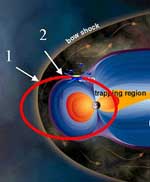
Image credit: ESA
The European Space Agency’s Cluster spacecraft were perfectly positioned to watch the effect of the recent solar storms on the Earth’s magnetosphere. Normally the magnetosphere bubbles out in front of the Earth by about 64,000 km, but during the storm it was down to only 43,000 km. The speed at which the magnetosphere compressed will help scientists calculate the power of the storm, and make more accurate predictions for what will happen in future storms.
On the 24th of October 2003, the SOHO spacecraft registered a huge Coronal Mass Ejection (CME), emitted by the Sun. Several hours later this eruption reached the Earth and was detected by a number of spacecraft including Cluster.
The ACE spacecraft, situated along the Sun/Earth direction, was situated about 1 500 000 km upstream from the Earth, monitoring the solar wind. At about 14:49 UT, ACE recorded a sharp increase on the proton velocity, which jumped from about 450 kms-1 to more than 600 km-1 . The proton density, which was about 3 to 4 particles cm-3 , increased to more than 20. The proton temperature in the solar wind at this instant was also multiplied by a factor of 8.
The four Cluster spacecraft were in the southern magnetospheric lobe, inbound towards their perigee. Note that the Sun, ACE, Cluster and the Earth were almost aligned when the CME was ejected from the Sun. Cluster was situated close to the inner magnetosphere (near to the ring current region) when it detected the effects of the solar wind pressure on the magnetosphere: The sudden increase of the solar wind pressure registered by ACE arrived at the Earth?s magnetosphere about 40 minutes later. It provoked a huge compression of the dayside magnetosphere. The Cluster spacecraft detected this compression by getting suddenly out of the southern magnetospheric lobe into the Magnetosheath. They thus detected the Magnetopause, moving earthward, at about 15:25 UT. They remained into the Magnetosheath until about 17:00 UT, when they were only at a 6.8 RE (Earth radii) distance from the Earth. The transition between the lobes and the Magnetosheath was characterised by an important ion density increase (from close to 0 in the lobe to more than 160 particles cm-3 in the Magnetosheath) as well as a very clear signature in the velocity components, as measured by the CIS experiment onboard Cluster (P.I: Henri R?me).
This is a very unusual position for the Magnetopause, which on the average is standing ahead of the Earth at about 10 to 11 RE. Such compressions can have dramatic space weather effects, particularly to geostationnary satellites which are orbiting the Earth at a distance of about 6.6 RE. Further analysis of the four spacecraft data will tell us at what speed the magnetopause moved which will give information on the strength of the CME.
Original Source: ESA News Release
